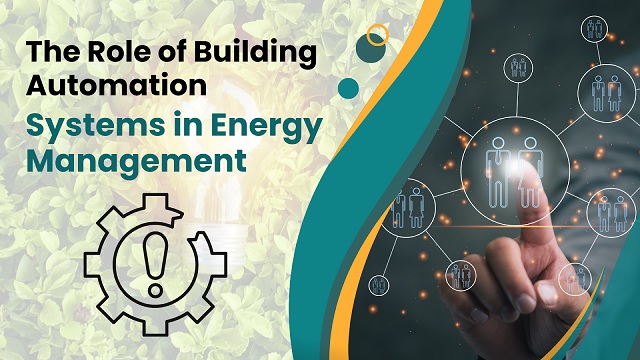
The Role of Building Automation Systems in Energy Management
Maintaining energy efficiently is essential, particularly if you are in big buildings. That is when building automation systems come in. Imagine BAS as the smart brain of a building – it keeps an eye on all the electricity and machines, making sure they work just right.
This clever system serves as a crucial part of the energy management of modern commercial buildings. By completely tracking and managing mechanical and electrical systems, Building automation systems aid in improving the usage of energy and preserving processing efficiency. For facility managers looking to decrease the consumption of energy, increase sustainability and understand the long-term cost savings, fostering a solid building automation system is a tactical need.
BAS is like a superhero that controls everything, making buildings eco-friendly and efficient. In this article, we’ll dive into how BAS works its magic, optimizing energy use and making buildings greener and more cost-effective. So, get ready to uncover the secrets behind these energy-saving superheroes – the Building Automation Systems!
Comprehensive Control and Optimization
The power of a great Building Automation System (BAS) comes from its smart control that helps a building use energy wisely. Modern BAS does this by gathering information from sensors on things like heating, cooling, and lights. These sensors tell the BAS about how things are used and predict the weather and how many people are in the building. Commercial building energy management systems like Trane OptiFlex utilize advanced BAS capabilities to reduce energy consumption.
Using all this info, the BAS makes clever choices. It decides the best temperature settings and when things should turn on or off. This way, the building uses just the right amount of energy without wasting any. Unlike basic systems, a super BAS knows everything that is happening in the building. It can even change how long machines run to save energy during different times of the year.
The BAS can learn a lot about how things work by putting sensors in the right places and keeping them accurate. It watches stuff like temperature and how well machines are working. With this real-time info, the BAS can find ways to make things even better. It helps cut down on energy use, which is great for saving money and being kind to the environment
Maintaining System Tuning
After a Building Automation System (BAS) is set up to work its best, it’s important to ensure it keeps working that way. Think of it like tuning a guitar – you need to keep adjusting it to sound good. While regular systems can start working less well over time, a smart BAS can catch these changes and fix them.
Imagine if you set your room’s temperature, but over the months, it gets too hot or too cold because the settings drift. That’s where BAS comes to the rescue. It has a built-in brain that notices when things aren’t right. If something goes wonky or you use too much energy, the BAS spots and fixes it. Instead of waiting for someone to check, the BAS takes action itself.
So, just like a musician tunes their instrument, BAS keeps fine-tuning the building’s systems. This way, the building stays efficient, using the right energy and not wasting any. It’s like having a super-smart helper that ensures things run perfectly.
Time and Cost Efficiency
Building managers have a big job making sure buildings run smoothly and use energy well. They need to set schedules, watch equipment, understand how things are used, and fix problems – all of which can take up a lot of time. But with smart automation, things become much easier.
A top-notch Building Automation System (BAS) makes things simpler. It gathers data, makes smart decisions, finds issues, and creates easy-to-understand reports. This helps the people in charge spend less time doing hands-on work. Instead of checking everything manually, the BAS does the heavy lifting.
Imagine having a control center where you can quickly see how everything is doing. That’s what a great BAS gives you. It also watches things all the time, so you don’t need to check the equipment constantly. If something’s not right, the BAS spots it early, allowing fixes before things get worse. This kind of automation saves money by preventing big problems and keeping things running.
So, just like having a helpful assistant, BAS takes care of the hard stuff, letting building managers focus on making things even better.
Enhancing Occupant Comfort
While most facilities aim to minimize energy costs, occupant satisfaction with their environment is an equally important performance metric. Temperature, indoor air quality, lighting levels, and ventilation rates all impact comfort and productivity. A modern BAS leverages granular system control and data visualization to optimize these parameters.
Critical building areas like healthcare facilities and research labs have stringent environmental requirements. Precision air handling is vital and any deviation can impact occupant health or jeopardize experiments. The automated control platforms of BAS can maintain and adjust parameters in sensitive zones to ensure optimal comfort and safety conditions at all times.
Performance Management and Reporting
Tracking key performance indicators (KPIs) like energy use intensity (EUI) is essential for monitoring building efficiency. Building automation systems have powerful trend-logging and analytics capabilities to measure performance against benchmarks and targets. Data points can be consolidated into energy models and dashboards to provide actionable insights on consumption.
The reporting functionality within a BAS allows operators to extract equipment run hours, schedule adherence, and fault occurrences over custom periods. Teams can diagnose underperforming assets, quantify savings opportunities, and justify upgrade investments. By establishing automated performance workflows, the BAS enables continuous optimization rather than sporadic commissioning.
Innovations in Building Automation Systems
Building automation capabilities have expanded exponentially from pneumatic controls to the AI-driven systems of today. One key innovation is the shift from proprietary communication protocols to open standards like BACnet and LonWorks that allow multi-vendor device integration. Internet of Things technologies have also enabled remote BAS access via web and mobile apps.
With the economies of scale, BAS costs have dropped substantially to make automation financially viable for small and mid-sized buildings. Edge controllers now provide targeted monitoring and control for specific equipment or zones at an accessible price point. Demand response capabilities allow the BAS to modulate building load in response to a stressed or dynamic power grid.
Cloud platforms and machine learning present new opportunities to extract hidden operational insights from BAS data. By establishing centralized control over multi-site portfolios, managers can optimize performance across their entire building ecosystem. As cyber threats grow, new security features like encryption and access control preserve data integrity.
Frequently Asked Questions
How does a Building Management System differ from Building Automation Systems or Building Energy Management Systems?
These terms overlap in functionality but have nuanced definitions. Building automation systems specifically focus on controlling electromechanical equipment like HVAC and lighting. Building management systems take a broader view to include security, maintenance, and business analytics, in addition to automation. Building energy management systems specialize in energy performance tracking and optimization.
What are the primary challenges in implementing a BMS in older buildings?
Retrofitting automation in older buildings can be hampered by out-of-date control components, inability to install new communication wiring, lack of system documentation, and insufficient sensing points. However, automation system vendors offer solutions tailored to legacy buildings including wireless sensors and controls compatible with older equipment.
How does a BMS contribute to achieving sustainability goals in modern infrastructure?
By optimizing energy use, maintaining performance, reducing waste, and extending equipment lifetime through proactive maintenance, building automation is integral for sustainable building operations. BMS data helps facilities quantify their environmental impact and green building certifications like LEED encourage the use of automation.
Conclusion
Building automation systems offer an indispensable tool for commercial facilities aiming to reduce energy consumption, operating expenses, and environmental footprint. With capabilities spanning data-driven optimization, efficient operations, occupant comfort, and performance management, modern BAS solutions deliver multidimensional value. Facility managers today are leveraging automation intelligence to create dynamically efficient, sustainable, and resilient building environments.

